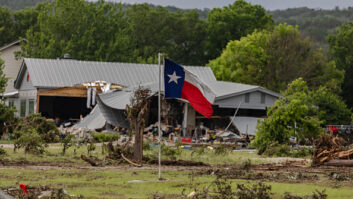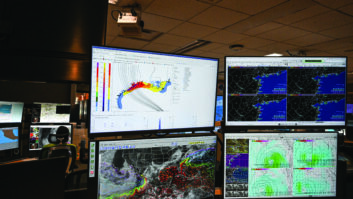WASHINGTON — Broadcasters are supposed to have Common Alerting Protocol-compliant EAS equipment in place June 30. Though some stations will still be waiting on backordered equipment at that time, no one was predicting a third deadline extension from the FCC.
Industry participants say Emergency Alert System “stakeholders” in general appear to be ready for CAP. To be sure, there are still doubters. Questions remain about how legacy EAS and CAP-compliant gear will meld, and how stable and efficient the new system will be. But most observers contacted for this story expect limited surprises at deadline.
This rollout is but one part of a broader digital emergency alert blueprint dubbed the Integrated Public Alert and Warning System, created by the Federal Emergency Management Agency. Proponents of the architecture are trying to create a system that can operate across electronic communications media including radio and TV, cable, the Internet and many wireless devices.

By June 30 broadcasters must have equipment in place capable of converting CAP messages into EAS messages and then processing them like EAS messages, said Harold Price, right, of manufacturer Sage Alerting Systems, shown here at the spring NAB Show. Colleague Gerry LeBow is at left. Photo by Jim Peck CAP data can include audio, video and text messages sent to TV, radio, cell phones and other wireless devices. It is compatible with existing alert formats like EAS as well as the Specific-Area Message Encoding (SAME) system used in Weather Radio plus new systems like the Commercial Mobile Alert System (CMAS) via which wireless providers transmit alerts as text messages. CAP also supports features like multiple languages, geo-targeting and the capability to add digital images. As Radio World has reported, FEMA is working with third-party developers such as Pandora, Google and AOL to distribute IPAWS alerts.
Most public warning experts agree that improvements in emergency message delivery by broadcasters will be gradual.
“The June 30 deadline will likely not be detectable by listeners, right away, as this change is, basically, the connection of a bigger and more capable pipe to equipment installed at broadcast stations that send these messages to the public,” said Clay Freinwald, chair of the Washington State Emergency Communications Committee.
A CAP message converted from text to speech might be the biggest noticeable change for radio listeners, because it will have the benefit of more information delivered intelligibly.
Richard Rudman, vice chair of the California SECC, said, “TV audiences will probably first start to notice a difference when local AMBER coordinators attach pictures to CAP messages, and EAS TV crawls will not be limited to the ‘canned’ SAME child abduction message. I am not sure if any states are doing this yet.” But, he said, “classic SAME messages” will continue for radio.
FEMA maintains a list of “alert originators” with authorization to send CAP messages; these include the National Weather Service and some local and state emergency managers, according to a person familiar with the system. (FEMA declined to provide the list for this article.)
The National Weather Service began pushing warnings, watches and advisories to IPAWS in the CAP version 1.2 format in late May. It expected to enable weather warnings to pass through to the wireless industry CMAS in mid-June and to the broadcast industry’s EAS in late summer, according to Mike Gerber, program lead for the NWS emerging dissemination technologies division. Some broadcasters have already been receiving CAP messages from FEMA during closed circuit weekly tests since early spring.
BACKLOGGED ORDERS
The FCC adopted new rules in Part 11 governing how broadcasters are to receive CAP messages. The commission’s Fifth Report and Order was released in January. The commission is responsible for implementing and enforcing the new standards, according to an agency spokeswoman.
By June 30, broadcasters must have operational equipment capable of converting CAP messages into EAS messages and then processing them like EAS messages, said Harold Price of manufacturer Sage Alerting Systems. “Being able to show that you have CAP equipment, and that it is hooked up to a CAP source and is operational — meaning that it is turned on, configured and connected to your air chain — should be sufficient to show that you have met the requirements of the revised Part 11.”
Officially, compliance will be expected at the deadline; stations not equipped would be subject to enforcement actions. The FCC in its order stated clearly that temporary waivers would be warranted only for stations in areas that lack broadband Internet access. Any such extension would be for a maximum of six months, according to the R&O. As of early May FCC officials had received no waiver requests from broadcasters.
“The FCC has completed all necessary work in advance of the June 30 deadline,” said Tom Beers, chief of the policy division for the FCC’s Public Safety and Homeland Security Bureau.
Beers said broadcasters can’t pretend that they are just getting notice of the CAP transition now. “Nearly five years ago, in 2007, it became widely known that the FCC adopted the requirement that EAS participants have the capability to receive CAP-formatted EAS alerts.”
Unofficially, industry insiders expect the FCC probably will not start inspecting immediately, though there’s no assurance of this, and any grace period is likely to be short.
Bob Cauthen of dealer SCMS reported backorders in June for equipment from Sage and Digital Alerting Systems; he expected to fill those by mid-July. His company is offering each customer an acknowledgement showing order date and estimated delivery date for their records.
‘A More Resilient EAS’
Officials at the Federal Emergency Management Agency look at the CAP deadline of June 30, 2012, as a major milestone in EAS and public warning. “Another step in the process toward a more resilient EAS” is how Manny Centeno, program manager for the Integrated Public Alert and Warning System at FEMA, described it.
IPAWS is the Internet infrastructure by which new and existing public alert and warning systems will integrate information based on the Common Alerting Protocol standard. Centeno has been intimately involved in testing IPAWS and CAP.
“The FEMA gateway, or the IPAWS aggregator, has been operating and is ready for all EAS participants to connect to,” he said. “For the past several months we have been sending out the weekly CAP tests to leverage and test the equipment. We are getting positive feedback.” In June, FEMA began sending daily CAP tests.
Centeno said FEMA has learned the value of tests and exercises to improve EAS systems in general. Among recent trials were EAN tests in Alaska in 2010 and 2011; tests in Nevada and Puerto Rico in 2011 using required monthly tests; and least five regional or state tests, all in addition to the national event in November 2011. The tests are designed to mitigate issues such as poor quality and low amplitude audio, Centeno said.
Audio quality should improve once FEMA’s satellite delivery network is completed. The system will send audio from FEMA headquarters to the current 63 Primary Entry Point stations nationwide.
FEMA hoped to test the uplink in June. “Thirty-two of the PEP stations are already equipped with the satellite equipment,” Centeno said in May.
He added that the FCC is in the process of updating EAS monitoring assignments and is urging states to begin work on new EAS state plans if they have not yet done so.
We reported in the May 23 issue that FEMA IPAWS Division Director Antwane Johnson expects a second national EAS test but not until regulators receive all the results from the 2011 event and address any technical issues.
The FCC remains concerned because some 40 percent of all EAS participants —radio, TV and cable — have apparently not filed their test results from the first national event. There was no verification function in the commission’s electronic reporting system for the national EAS test; now some stations are confused about whether the FCC received their test results. Beers recommended stations e-mail [email protected] to verify the agency actually has their results.
Though the electronic filing option is closed, the agency is still accepting results filed on paper.
“The commission continues to consider its options, and we continue to strongly encourage EAS participants that have not yet filed the required EAS test reports to do so,” Beers told Radio World in May.
The deadline for broadcasters to report data was Dec. 27, 2011. The agency has said it’s too early to draw any conclusions from the data staff has examined.
Meanwhile, FEMA continues to urge broadcasters to speak with station ownership and managers to become more active in EAS. Management and owner “involvement is crucial because many of the decisions made at the participant level are going to be made by those people,” said Centeno. “Everyone should continue to be motivated. We give our thanks to broadcasters for their patience and support.”
Harold Price said Sage recommended that broadcasters who face a backlog make notations on their EAS test logs that “they have equipment on order but that it just hasn’t been received yet and to be able to show verification of such.”
Estimates of compliance varied.
Darryl Parker, senior vice president of EAS equipment manufacturer TFT Inc., said approximately 35 percent of all EAS participants, including radio, cable and TV, were CAP-compliant as of June 1. He ballparks radio at 75 percent. He based his estimate on recent activity in the marketplace and his conversations with broadcasters.
Cauthen too, thought perhaps 75 percent of radio stations were compliant, though he added, “It is very hard for any of us to estimate this, as one unit is not required for each station and we have no way of knowing how many are collocated, etc.”
Dealer BSW reported “very brisk” ordering activity in recent weeks. “Our most popular unit is the Sage Digital Endec and right now the factory is in a backorder situation with units not expected to arrive prior to the June 30th deadline,” President/CEO Tim Schwieger said in early June.
“BSW has made an effort over the last year asking our customers to order early and many did just that; unfortunately there are also many stations that were not in a favorable financial situation that allowed early ordering and now are without a unit.”
Clear Channel Media and Entertainment is the largest station owner. Steve Davis, senior vice president of engineering, facilities and capital management, said all of its approximately 850 stations are CAP-compliant. “We intend to do an internal test this month before the deadline to confirm and address any problems we uncover,” he told RW in early June.
CONVERTERS
Sage Endec users must install a software update to begin polling the IPAWS server. The update was to be released in June.
“We’ve developed a simpler installation procedure so that engineers only need to install the firmware, they won’t need to also update their settings,” Price said. “This will save a lot of time, especially for engineers with multiple stations to support.”
Another angle of ongoing interest is the use of CAP converters. Stations that settled on these intermediary EAS devices — as a less expensive alternative to outright replacement of legacy EAS gear — may have only a few years to use them.
An intermediary device or “converter” is a standalone box that monitors, receives and decodes CAP-formatted messages to convert and load them into a separate legacy EAS device. In the Fifth Report and Order, the FCC mandates that intermediary devices must be capable of using the enhanced text of a CAP message to provide a visual display by June 30, 2015. Communications attorney David Oxenford wrote that not all intermediary devices are capable of using enhanced CAP text. “Therefore these devices may only be a short-term solution.” (Formerly with Davis Wright Tremaine, Oxenford has since joined Wilkinson Barker Knauer.)
Bill Croghan, chief engineer for Lotus Broadcasting in Las Vegas and co-vice chair of the Nevada State Emergency Communications Committee, questions the “false economy” of an intermediary device. “In my opinion, the money spent on intermediary devices would have been better invested in new gear that would last a while.” Lotus Broadcasting purchased Sage encoders/decoders for its radio stations in Las Vegas, replacing older TFT and Burk units.
However, Jim Gorman, president of EAS equipment manufacturer Gorman-Redlich, said concerns that intermediary devices will become obsolete are overstated.
“The enhanced text referenced is constructed from various text fields within the CAP message. The Gorman-Redlich CAP-DEC 1 already generates this enhanced text and displays it on the user interface. Additionally, the unit is capable of sending this text to certain signboards and character generators,” Gorman said.
“We see no reason why, once requirements are finalized, the CAP-DEC1 would have any problem complying well in advance of such a deadline.”
On another technical note, the FCC in April cleared up an ambiguity when it released an Order for Reconsideration on the “text-to-speech” issue. In the revision, the FCC said it will allow the use of TTS to convert emergency alerts from text to speech. A number of groups had pushed the commission to reconsider an earlier prohibition.
TRANSITION PROCESS
Beyond these questions, the transition from legacy EAS will, in the opinion of another participant, bring some bumps.
“From what I’ve seen, the new CAP EAS technology lives up to the hype, but I don’t think there will be a smooth transition from the old system to the new one because right now there are too many gaps in the transition process,” said Adrienne Abbott, Nevada SECC chair and a member of the Broadcast Warning Working Group.
Abbott said she fears there will be inconsistencies in what the “public sees and hears during times of emergencies.”
People don’t get all the facts the first time they hear a warning so consistency across all platforms is crucial to saving lives, she said. “With CAP, emergency officials will be able to put out a detailed text message that broadcasters can use as it comes with the EAS activation, but only if the broadcaster has equipment that has full CAP capabilities.”
Other EAS proponents worry that some states haven’t done enough to embrace the new CAP-EAS to bring a new enhanced and improved warning system to bear. Only about half of the states have added some form of CAP messaging technology; that means 25 states or more are still depending on last-century methods for public warning, according to Suzanne Boucher, state EAS chair for Maine.
“It would be a shame to think that broadcasters and other EAS participants invested millions of dollars in equipment and technology that can truly enhance our alerting capability, only to have state and local alert issuing authorities continue to shun EAS out of fear or ignorance,” Boucher said.







